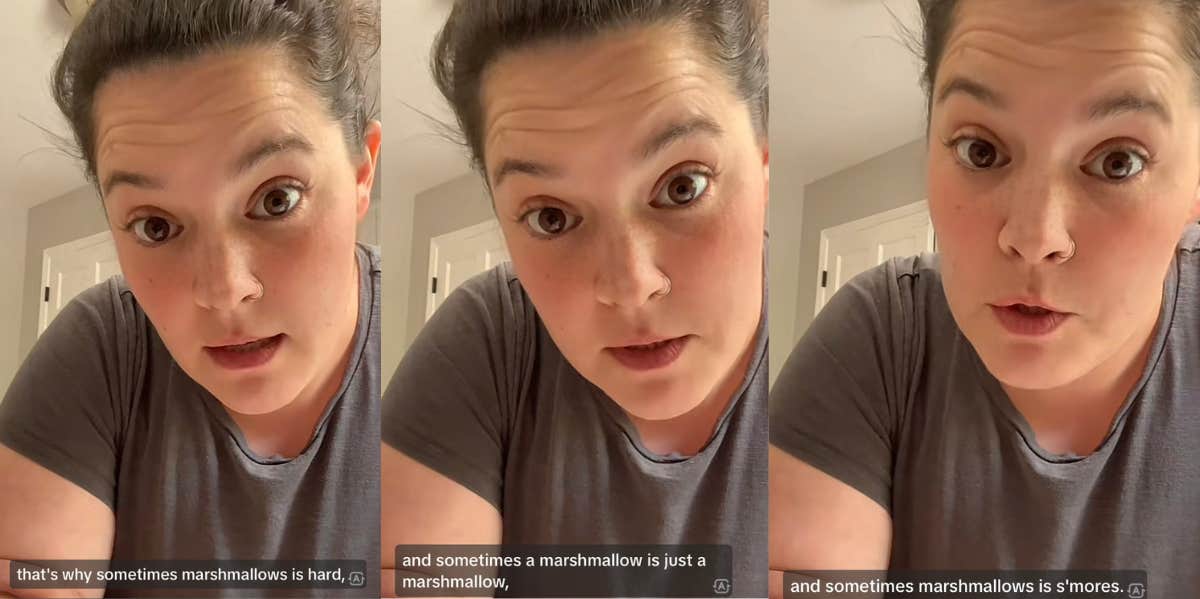Foster Mom Shares Why Marshmallows Were Her Foster Daughter's Trigger — And How The Snack Also Helped The Little Girl Heal
This foster mom is a perfect example of what children with trauma need most.
 @one_more_arrow / TikTok
@one_more_arrow / TikTok An enormous 79% of foster children are put into the system because of child neglect. Due to the neglect they receive, those children are traumatized.
Sadly, this is the case for TikTok user Grace's (@one_more_arrow) foster daughter.
Grace’s foster daughter 'Firecracker' revealed how marshmallows trigger her trauma.
In her video, Grace explained how she took Firecracker to Target one morning to pick out some things that she liked since they were working on structuring her identity without the influence of other people. Firecracker chose marshmallows as her snack.
The two were in the car and Firecracker was eating her marshmallows when she said to Grace how marshmallows can be “sometimes hard, sometimes marshmallows is just marshmallows, and sometimes marshmallows is s’mores.”
Grace encouraged Firecracker to elaborate on that. Before Firecracker lived with Grace, she lived in an abusive home. At this home, there was a bag of marshmallows at the bottom of the pantry.
“When things were going on that were not safe, she would go into the pantry and she said she would lick the marshmallows until somebody could get her food to eat. They were hard, they were hard as rocks because they were old,” Grace explained.
Firecracker went on to explain how marshmallows are sometimes just marshmallows. She reminded Grace about her 5th birthday party when they roasted marshmallows and put them on a graham cracker with chocolate, but she didn’t eat hers. Firecracker apologized for not eating hers and Grace said, “It’s okay sweetheart, it’s just a marshmallow.”
Lastly, she recounted the time when they all made s’mores again, but she ate hers and the marshmallow was soft. Firecracker requested that Grace put her marshmallows on the bottom shelf of the pantry. Grace put them in an airtight container and obliged. “They won’t be hard, baby girl,” she said as she put them on the bottom shelf.
“I have been a foster parent for nearly 7 years. I still can’t always predict what things will be triggers for the kids who enter my home. But kindness and gentleness always go a long way. And sometimes, healing looks like choosing marshmallows for a snack just because you can... and because now you know they’re soft,” Grace wrote.
The foster care system is certainly not perfect and the system, overall, is failing.
According to Foster America, the neglect that the children who enter foster care are facing is most commonly due to poverty: “Current child welfare policies make family separation an easier option than providing supportive services to children and parents with complex needs.”
They claim that the system is failing because:
- 1 in 8 children are abused or neglected by the age of 18.
- 1 in 17 kids enter foster care.
- 70% of youth involved with the juvenile justice system have been involved with foster care.
- 60% of human trafficking victims have histories in foster care.
- 33% of homeless young adults were in foster care.
These statistics might largely be directly related to the trauma that children in foster care deal with.
All children in foster care have been exposed to some type of trauma from their families and from being put into the system. Being put in foster care means the loss of the child’s “birth family, friends, schoolmates, teachers, and everything familiar.”
It is imperative for foster parents to be able to understand trauma in order for the children to have any chance at healing.
AdoptUSKids reported, “Ongoing trauma often disrupts children’s sense of security, safety, and sense of themselves and alters the way they see and respond to people and situations in their lives.” These children may have developed unhealthy habits, such as aggression, which may have helped protect them in their previous environments.
Children may experience triggers from this trauma, like Firecracker’s initial aversion to the marshmallow, and it is the foster parent’s responsibility to help them heal and recover.
According to experts from AdoptUSkids, this can be achieved through being loving, kind, and patient with a foster child. Also, it is imperative to be able to talk things through since the child may not understand why they are feeling a certain way.
Another way to help a child through their trauma is to try to understand it and how it impacts the child. It is essential to realize that it is going to take a long time for the child to heal from the trauma, so don't expect results to happen overnight. Lastly, seeking resources such as parenting groups, counseling, or a pediatrician is always a good idea.
Grace was certainly modeling many of these tips in her video. Especially by being loving, kind, and gentle toward Firecracker’s trigger and talking things out with her.
It is so amazing that Firecracker has been placed in a loving family that is willing to help her to heal from her past traumas in her own way. This is the ultimate goal of the foster care system.
Tarah Hickel is a Washington-based writer and is a frequent contributor to YourTango. She focuses on entertainment and news stories including viral topics and human interest pieces.

